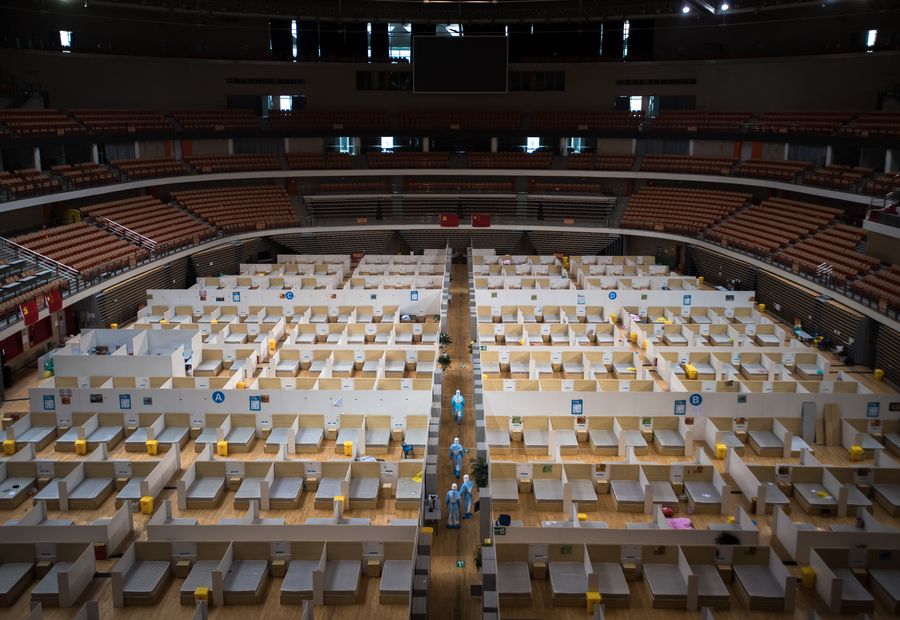East Asia Blog Series
Fangcang Hospitals: Essential to Battle Disease and Disaster

In February 2020, millions watched videos showing gyms, a stadium, and other buildings in Wuhan, PRC transformed into makeshift treatment centers. Timelapse videos captured the Huoshenshan and Leishenshan hospitals being assembled in 10 days like giant Lego structures. Known even outside the PRC as fangcang hospitals, 12 were fully operational in February, with 13,348 beds. Some were set up in school dorms, vacant factories, warehouses, and passenger terminals. By March, 16 facilities were serving the city of 11 million.
Since December 2019, the coronavirus disease (COVID-19) had sickened thousands in the city, overwhelming traditional hospitals. Wuhan fought back with fangcang hospitals.
The PRC is no stranger to public health crises. It had endured the SARS epidemic of 2002–2003, for example, and set up a fangcang hospital in Yushu, Qinhai after the 2010 earthquake. But the scale of the COVID-19 pandemic was unprecedented and required extraordinary measures.
Fangcang hospitals are like military field hospitals, which follow armies into battle. And Wuhan was at war with the pandemic, with casualties as bad as those seen in combat. By March 2020, about 2,500 in the city had died and 50,000 had fallen ill.
While military field hospitals treat all the wounded, however, fangcang hospitals treated only those mildly and moderately infected (80% of all cases) who could not quarantine at home or be trusted to stay home. The fangcang hospitals freed up general hospitals to care for only severe cases and designated hospitals to treat only critical cases. The fangcang hospitals also allowed other hospitals to resume treating patients with other serious ailments in need of specialized care.
Fangcang hospitals can be built rapidly on a massive scale and at low cost. Their functions are isolation; triage; basic medical care (including mental health counselling); frequent monitoring and rapid referral; and essential living and social engagement (including food, hygiene, emotional support, and mood-lifting activities such as dancing). And running them is inexpensive: they need fewer doctors and nurses as all the patients have the same illness, reducing the complexity of care.
The images of the pandemic are harrowing, including long lines of the sick outside hospitals in many countries. Those who could not be hospitalized stayed home, where they might worsen and could not be monitored, and infected their families. Or they moved about, risking infecting the public. Wuhan shows that fangcang hospitals should be in countries’ public health arsenal against not just COVID-19 but also future epidemics and emergencies.
In ADB developing member countries that lack health-care facilities and health human resources, especially during crises or disasters, fangcang hospitals are a powerful weapon. They don’t need enormous amounts of time or money or highly advanced technology to be set up.
The Philippines had 10 fangcang hospitals by April 2020. One, in a convention center in Manila, had almost 300 beds, learned from the Wuhan experience and worked with PRC medical teams. Outside Manila, local governments retrofitted existing public facilities, where the mildly and moderately infected could isolate and be cared for and monitored. In July 2020, on the day that India reported its biggest spike in infections, it opened the world’s largest single temporary hospital, with 10,000 beds. In Tajikistan, in May 2020, new state buildings were turned into four temporary hospitals, two of which had ICUs and ventilators, and a mobile hospital for quarantine was assembled in a stadium using 144 containers provided by the Government of Uzbekistan.
Hospitals in Indonesia sometimes set up tents in their parking lots to manage the number of people seeking help. An unused luxury hotel in Cambodia was turned into a 500-room COVID-19 hospital in March 2021. The 300-bed fangcang hospital in Lao People’s Democratic Republic closed in June 2021 after cases dropped but is prepared to reopen. In the Kyrgyz Republic, the pandemic peaked in July 2021 and a dozen “pop-up” hospitals opened in Bishkek’s gyms, hotels, and restaurants, and night-time temporary hospitals treated 9,203 patients.
Even the United Kingdom and the United States resorted to using fangcang hospitals at the height of the pandemic.
The market for fangcang hospital equipment is expected to grow in 2021–2027, with the PRC, Japan, the Republic of Korea, India, Australia, Indonesia, Thailand, Philippines, Malaysia, and Viet Nam constituting an important segment.
A study on Wuhan concluded that traditional hospitals saved the lives of patients with severe COVID-19, but it was the fangcang hospitals that helped slow and stop the pandemic. If the fangcang hospitals had been opened a day later, COVID-19 cases would have totaled more than 7.4 million instead of 50,844, about 1.4 million instead of 5,003 would have died, and the epidemic would have lasted 179 days instead of 71.
The world will face other pandemics and natural disasters. The lesson of COVID-19 is that countries must be prepared. Developing countries’ health systems, however, will continue to be inadequate for a long time. The lesson of Wuhan is that fangcang hospitals can fill in the gaps.
Authors

Najibullah Habib
Senior Health Specialist, East Asia Department, ADB

Muriel Ordoñez
Writer and Editor (Consultant)


